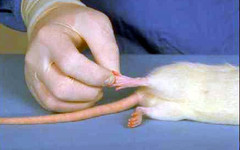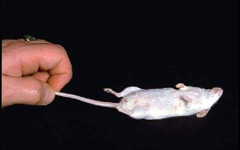Response to external stimuli
An animal that is alarmed by environmental stimuli will display freezing behaviour, alternating with scanning. Both behaviours will disappear when the animal is at ease again.
A deviant response to a stimulus can be determined in several ways. Most tests are geared towards demonstrating a weakening of a reflex, such as the closure of the eyelid when an object approaches the eye (eyelid reflex), the narrowing of the pupil in response to light (light reflex), the response to noise (such as clapping hands above the cage, see movie 1), the toe pinch reflex and the tail pinch or flick reflex (see pictures and movies 2 and 3).
Reponse to handling
handling an animal has a function in detecting pain/distress since the investigator/animal care worker can focus on abnormal signs that may not be specific items on the score sheet (e.g. weight loss, hypothermia, the presence of tumors). Responses which may be observed on handling include: vocalisation, aggression, lethargy, or weakness (see movies 4 and 5).
Righting reflex
When an animal is placed on its back, it will immediately attempt to return the body to an upright position. This righting reflex may be abnormal or even absent (see movie 6). This is often indicative of serious health problems, sometimes of a neurological nature, but more usually, exhaustion. The inability of an animal to get to its feet can be a clear indication for euthanasia.
Response to noise
Rodents are sensitive to sudden noises particularly in the high-frequency range, such as ultrasound. This sensitivity can be lowered somewhat by playing background music continuously (keeping the radio on). The animal’s reaction to sound can be tested by making a sudden noise e.g. hand clapping above the cage (see movie 1). A healthy animal will respond with a startle reflex: it jumps up, then freezes, and hunches. A response to noise that differs from the above needs to be investigated.
Response to light fluctuations
A light intensity of more that 25 lux will awaken an animal from sleep, after which it will leave its resting place to find a darker location to go back to sleep. The red light response test consists of switching off all normal lighting and observing the animal in a dark environment (with infrared lighting, if needed). A healthy nocturnal animal will become active within five minutes; it will start grooming, stretching, exploring, climbing, or playing. Albino specimens do not tolerate light well. The absence of a (protective) pigment in the eye makes it susceptible to damage from prolonged exposure to > 60 Lux, which can cause degeneration of the retina.
Interaction with conspecifics
By nature, rats and mice are social critters who need the interactions with their own kind (both while resting and while active) to be able to function optimally. Their social behaviour covers a wide range of activities. Aggression intended to determine the social hierarchy in the group may be an aspect of this behaviour. Aberrant behaviour directed at cage mates is a reason for heightened vigilance.
solitary housing in rodents can cause aberrant behaviours such as stereotypic behaviour. With the exception of adult male mice, solitary housing should be avoided. Should this be unavoidable, then it is important to organize the housing in such a way that exchange of scents and sounds with conspecifics can take place and that cage enrichment is provided (see movie 7).
Interaction with the environment
As soon as an animal is placed in an unfamiliar environment, it will start to engage in exploratory behaviour (see movie 7). This helps it to get to know its surroundings, which then become controllable and predictable. Controllable means that the animal can exert an influence on its environment such as make a burrow. This way, the animal can adapt its environment to its needs. Predictability means that an animal can predict what will happen.
Controllability and predictability contribute significantly to laboratory animal welfare.









